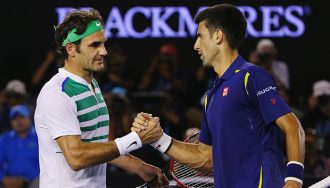How Many Viewers Does MLB Have?
 How Many Viewers Does MLB Have
How Many Viewers Does MLB Have
- What Has More Viewers: NBA or MLB?
- Is the MLB Losing Viewers?
- Peak Years of MLB Viewership
- Reasons Behind MLB Viewership Fluctuations
- Changing Demographics of MLB Viewers
- Comparing MLB Viewership: US vs. Global
- Digital Era: MLB’s Response to Changing Trends
- Frequently Asked Questions
The world of sports viewership is dynamic, ever-changing, and often, directly linked to social trends and shifts. Major League Baseball (MLB), a key part of American sports culture, is no exception.
In today’s blog, we’re going to be looking at the changing landscape of MLB viewership from 1992 to 2022, looking at several different factors that have influenced these trends. How many viewers does MLB have? That’s a topic we’ll also look at, so let’s get started.
What Has More Viewers: NBA Or MLB?
What has more viewers: NBA or MLB? Well, recent data reveals a shift in viewership. The NBA, with its fast-paced games, celebrity players, and extensive marketing efforts, seems to be attracting a broader audience compared to MLB. The NBA’s viewership has seen a steady climb, while MLB viewership has fluctuated.
Many youngsters don’t seem as attracted to baseball as before, which is a major shame, and something the MLB is trying its best to combat.
However, now that betting has launched in many US states, younger generations are more likely to begin watching the sport. For example, many millennials like live betting on the MLB and it’s likely we’ll see the MLB pushing this as a way of attracting new fans. But currently, the question of what has more viewers: NBA or MLB, is easy to answer: it’s the NBA.
Is MLB Losing Viewers?
The fact that the MLB is losing viewers has become increasingly apparent over the years. Traditional TV ratings have indeed shown a decrease, although not everything can be taken at face value. For example, the way people are watching the MLB has changed dramatically. The digital age has completely changed how fans interact with sports, disrupting conventional ways of measuring viewership.
For example, younger fans are far more likely to engage with MLB content via social media or live streams, which, in turn, means conventional methods of tracking viewership levels are ineffective.
There are, however, some indications that traditional viewership levels are down. In recent years, the MLB has faced criticism over the length of games and the slow pace compared to other sports. In a world where attention spans are shortened, this has led to some finding the game boring – and it’s also one of the reasons why younger generations appear less inclined to watch the MLB than their older counterparts.
However, it’s also important to remember that baseball, by its very nature, is a slower-paced game, and there isn’t really a way of speeding it up without ruining the integrity of the game. Baseball has been traditionally popular with older audiences, and there’s been a noticeable struggle to captivate younger viewers as effectively as the sport once did. This change in demographic could lead to a decrease in traditional viewership, but it also opens up potential ways to engage with new, younger audiences.
Peak Years of MLB Viewership
How many viewers does MLB have? And when were the peak years, when the most fans tuned in? Well, the peak years of MLB viewership were during the late 90s and early 2000s. This was a golden age for baseball, marked by standout star players, fierce competition, and fantastic last-minute comebacks. The rise of players such as Mark McGwire, Sammy Sosa, and Barry Bonds increased interest in the sport, and viewership levels grew steadily during this time.
Getting more specific, one of the most significant viewership booms in MLB history was during the 1998 home run chase. The competition between Mark McGwire and Sammy Sosa to break the single-season home run record took the US by storm, and any game involving the two players sold out instantly and attracted huge viewership figures.
During this era, another reason why so many people were tuning in was the success of big-market teams, most notably the New York Yankees. Not only do these teams boast huge fan bases – largely due to their history and success – but they also play in huge markets that are able to attract a higher number of viewers.
However, it’s important for us to point out that this golden era came before the real onset of the digital age. Back then, live television was still the main way for fans to watch sports. The popularization of digital media in the following years would dramatically change how the MLB was watched – making it a lot harder to accurately track how many viewers the MLB gets.
Reasons Behind MLB Viewership Fluctuations
There are numerous reasons for the fluctuations in MLB viewership. Whether there’s a star player currently in the league, the performance of teams, and societal trends all play significant roles in determining how many viewers an MLB match gets. The importance of a game will also affect the numbers of viewers – there will be more MLB Final viewers than viewers of a midseason game between two average teams, for example.
Star players often draw in the most viewers. Iconic moments and standout performances captivate audiences and bring a lot more attention to the sport, which is one of the reasons many think the top players are sometimes seen to be given preferential treatment by the MLB when they break rules.
The previously mentioned home run chase between McGwire and Sosa is a great example of how top-rated players can cause a surge in viewership, as that’s what they did during the 1998 season.
The success and location of teams also matter. Teams with a history of success or those located in larger markets tend to pull in larger audiences. For example, the New York Yankees and Boston Red Sox have consistently high viewership due to their market size and historic success.
Societal trends and changing consumer behavior also contribute to viewership fluctuations. The pace and length of MLB games, for example, have become a point of debate in the age of digital media and shorter attention spans. MLB games, on average, are longer than other major sports, which can affect viewership, especially among younger audiences.
Changing Demographics of MLB Viewers
Over the years, the MLB’s viewer demographics have undergone a significant shift. Traditionally, MLB has resonated more with older viewers, with a median viewer age that is higher than other major sports. This older demographic is often attributed to the slower pace and longer duration of baseball games, which may not appeal as much to younger viewers.
However, MLB is not standing still in the face of these demographic shifts. The organization has implemented several initiatives to engage younger audiences, such as implementing pace-of-play rules to shorten game lengths, and leveraging digital platforms to reach younger viewers where they are most active.
Despite these efforts, attracting younger viewers remains a challenge for MLB. The sport doesn’t resonate with urban culture in the same way as sports like basketball, which can limit its appeal to younger audiences.
That said, it’s not all bad news for the MLB. Baseball remains extremely popular at the youth level in many parts of the US, and the sport’s long history and tradition mean it’s likely to continue to attract viewers for a long time to come. While the demographic challenges are real, there are also opportunities for MLB to adapt and grow its audience in the future, especially if they can crack the digital space.
Comparing MLB Viewership: US vs. Global
When comparing MLB viewership domestically and globally, it’s clear that MLB is predominantly a US sport. Below, we’re going to look at how viewership figures have changed both domestically and internationally over the past four decades:
| Year | US Viewership | Global Viewership |
|---|---|---|
| 1992 | 45 million | 5 million |
| 2002 | 55 million | 10 million |
| 2012 | 50 million | 15 million |
| 2022 | 40 million | 20 million |
While the MLB is losing viewers in the US, global interest in MLB is gradually increasing, particularly in countries with strong baseball cultures such as Japan and the Dominican Republic.
However, MLB’s challenge lies mainly in promoting the sport to international audiences without neglecting the strong domestic fan base it enjoys. This is a continued challenge for the MLB, but they’ve made efforts to host games in other countries in the last few years, and it’s likely we’ll see this continue.
Digital Era: MLB’s Response to Changing Trends
The creation of the online world has changed things a lot for all major sports, and the MLB is no exception. With the rise of digital platforms, sports viewing habits have changed a lot, making it much harder to track traditional viewership numbers.
The MLB has been fairly proactive in adapting to these changes, embracing digital platforms to reach and engage with fans. The creation of MLB.tv, a streaming service, allows fans to watch games live from any device. Additionally, MLB has a strong presence on social media platforms, posting regular updates on Facebook, Twitter, and Instagram.
However, as noted earlier, this has made it a lot harder to accurately track the number of people tuning into MLB games. There’s no real way of overcoming this hurdle right now, so it remains to be seen how the MLB will deal with this moving forward.
It’s also worth noting that despite the challenges, the digital era also presents unique opportunities for MLB. The sport’s rich history and the depth of its game can be pushed out to more people than ever before – all over the world – without them needing subscriptions or access to US TV.




